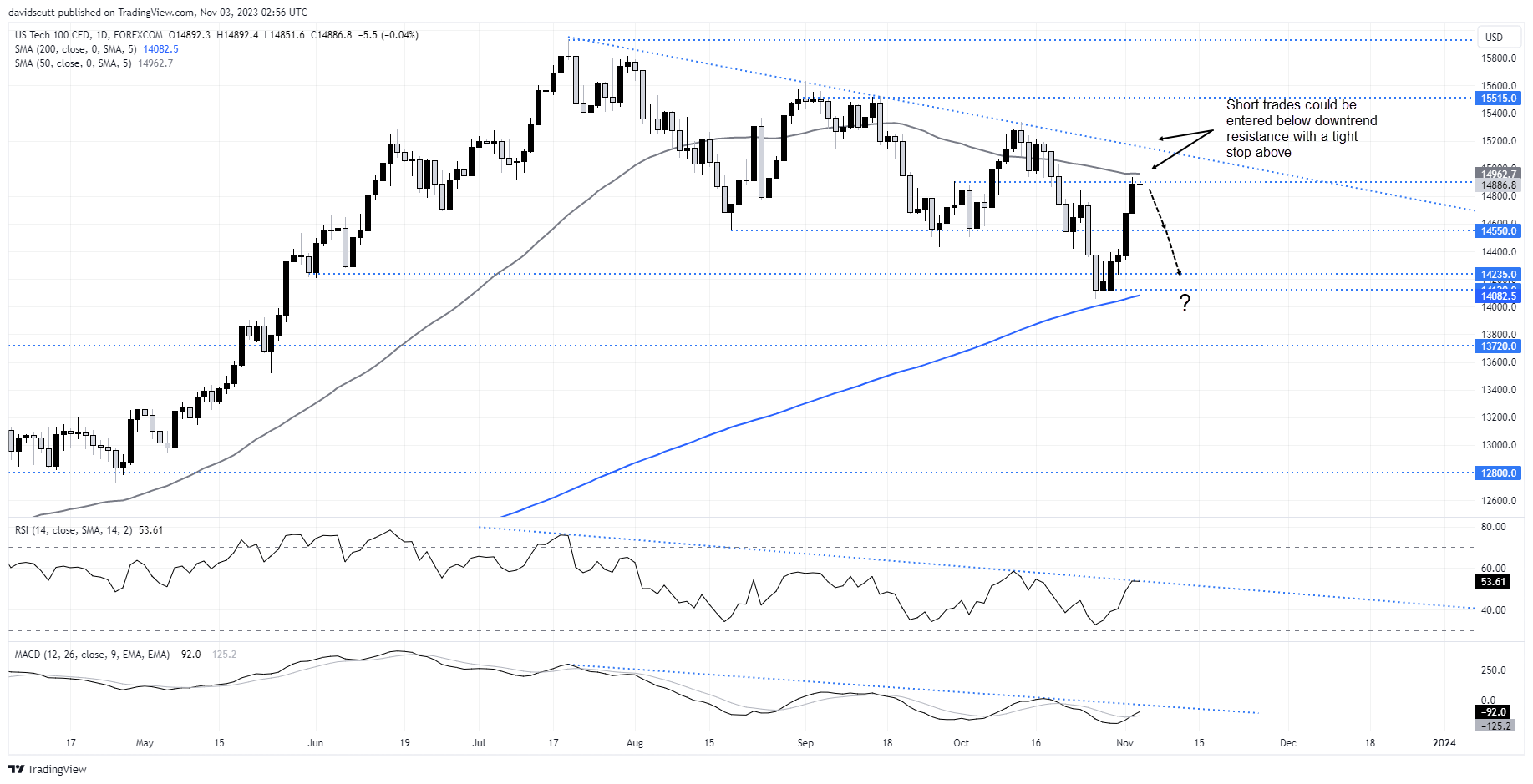
Nasdaq 100 faces reversal risk if dovish rates narrative unravels
- The Fed cited tighter financial conditions as a factor likely to restrain inflation earlier this week
- Ever since financial conditions have been loosening rapidly
- If incoming data remains firm, it may force the Fed to rollback the less hawkish tone offered only a few days again, increasing reversal risk
Fed cedes power to markets to finish inflation fighting job
When Jerome Powell stunned markets with an eight-minute hawkish speech at Jackson Hole last year, he warned “the historical record cautions strongly against prematurely loosening policy” to defeat inflation, pledging the FOMC would “keep at it” until the job is done.
For the most part, Powell has stuck to his guns, tightening policy through pockets of market volatility, refusing to lose sight of the goal. Despite progress in bringing inflation back to acceptable levels, his job is not done yet. Just look at underlying price pressures in the CPI and PCE reports for September, coming in far stronger than what markets expected. It’s still far too hot for comfort when labour market conditions remain so tight.
Fed not “keeping at it”
That’s why I was stunned the Fed has decided now, having come so far in the inflation flight, to offload the responsibility of finishing the job to financial markets by introducing financial conditions as a key consideration for policy settings.
“Tighter financial and credit conditions for households and businesses are likely to weigh on economic activity, hiring, and inflation,” the November FOMC stated, adding “financial” to the sentence offered three months earlier. It implies that if markets are doing the work in taming inflation, then there’s no need to continue tightening official policy rates.
This is not “keeping at it”. This is a mistake. It’s allowing markets to dictate how the Fed should respond to the inflation challenge. Is it any wonder risk assets have been off to the races since the meeting concluded, loosening financial conditions dramatically? This creates a huge problem for the Fed the longer it persists, unless near-term economic data confirms the loosening in conditions is warranted.
Strong US data risks hawkish tone and reversal risk
It makes the October payrolls and ISM non-manufacturing PMIs releases later today even more important. If they continue to demonstrate strength, it means the Fed will likely have to rollback the dovish messaging as quick as it arrived. Otherwise, inflation may accelerate again, making the same mistakes of the past that Powell wanted to avoid.
That’s the risk.
Unless we see payrolls and services activity soften, the hawkish messaging will have to return, creating renewed downside risk for those markets that ran the hardest post the Fed meeting.
Nasdaq 100 vulnerable to shift in rates narrative
The Nasdaq is one market that comes to mind after surging around 6% from the recent lows, taking it back towards downtrend resistance around 15170. With Apple down heavily in afterhours trade and having stalled around minor resistance at 14900 on Thursday, any change of narrative around the rates outlook will make it vulnerable to a reversal. It’s obvious plenty of shorts have been squeezed in recent days, so positioning is likely to be a lot more balanced than the start of the week. Interestingly, despite the speed of the move, RSI and MACD are yet to confirm a shift in momentum.
For those who believe the market has run too hard too fast, a short around these levels, or even a little higher if optimism in early European trade spills over into US futures, could us the proximity of downtrend resistance, allowing a tight stop to be placed above. On the downside, 14550 is the first target with 14235 and 200-day moving average at 14082 further below.
If the trade goes wrong with a break of uptrend resistance, traders will no doubt be thinking about the test of the 2023 highs just below 16000. That could present other trade opportunities, should it occur.

-- Written by David Scutt
Follow David on Twitter @scutty
How to trade with City Index
You can trade with City Index by following these four easy steps:
-
Open an account, or log in if you’re already a customer
• Open an account in the UK
• Open an account in Australia
• Open an account in Singapore
- Search for the market you want to trade in our award-winning platform
- Choose your position and size, and your stop and limit levels
- Place the trade










